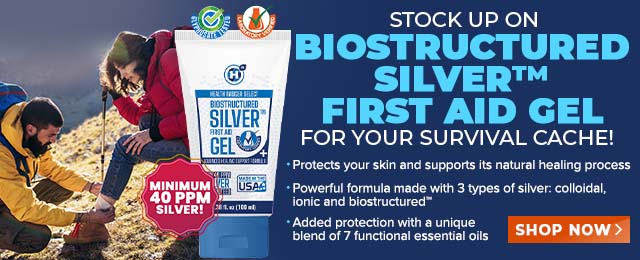
Phthalates Danger: Chemicals in Plastics Put Unborn Babies At Risk
Monday, August 10, 2009 by: S. L. Baker, features writer
Tags: phthalates, health news, Natural News
- Newly released JFK files reveal Pentagon's role in creating Lyme disease and covid in the same lab
- Analysis: The coming economic collapse, a mass uprising and Trump's three secret weapons to halt the growing revolt
- BIGGEST SCAM: You pay income tax, then taxes on purchases, then personal property tax on what you own that you already paid taxes on with taxed money
- The flu vaccine paradox: Are we making things worse?
- SHOCKER: Find out the REAL REASON that USAID was in AFRICA and other developing nations, and it wasn't for education, health or "democracy"
- BEWARE: USDA allows genetically engineered vaccines to infiltrate organic food production
- The hidden dangers of antibiotics & 10 natural antimicrobials to incorporate into your life
- Trump nominates VACCINE ZEALOT Susan Monarez to lead the CDC, sidelining RFK Jr.'s reform efforts
- Hillary Clinton calls for THOUGHT POLICE, echoing her persistent crusade for censorship
- Big Pharma's media takeover: How drug companies bought the news - and your health
- Obama accused of laundering USAID funds to fuel global protest movements, regime change operations
- Tesla, Elon Musk targeted by same useful idiot domestic terrorists that burned and pillaged American cities in 2020
- Federal government censorship – key nodes, and rabbit holes
- Festive flavors: The sweet history, nutritional profile and health benefits of pecan pie
- Heads up! List of food shortages expected in 2025 as the campaign of forced starvation continues to be waged against the American people
- Trump reverses course on Gaza plan, says “nobody is expelling Palestinians”
- Dr. Mike Yeadon releases 15-minute testimony - WATCH - about genocidal intent of COVID “vaccines”
- Survival 101: Effective EMF blocking techniques
- Elon Musk: Aliens could be here on Earth RIGHT NOW
- EPA advisor admits the agency is funneling billions to climate groups ahead of Trump’s return to White House
- Trump reverses course on Gaza plan, says “nobody is expelling Palestinians”
- Reclaim your health: How midlife exercise reverses years of inactivity
- A lack of integrity in Academia: Harvard professor found GUILTY of fraudulent research to promote CRT theory
- Space war brewing? Russia threatens to destroy Starlink satellites
- Big Pharma's $8 Billion bribery scheme exposed: how doctors are pushed to prescribe junk science, not heal
- Mike Adams Sermon 66: God will DESTROY ISRAEL for its wickedness
- Rep. Nancy Mace introduces bill to ban biological males from female facilities on federal property
- Survival 101: Effective EMF blocking techniques
- 5 Simple steps to boost your brainpower: How to strengthen executive function in a distracted world
- Historian warns Israel may be entering an “IRREMEDIABLE DECLINE”
- Florida takes a stand: DeSantis proposes permanent ban on mRNA vaccine mandates
- RFK Jr.'s SSRI antidepressant investigation sparks liberal meltdown, exposes Big Pharma's dangerous game
- New York politicians push bill allowing governor to indefinitely detain the unvaccinated on a whim
- Sales of survival bunkers rise following Russia’s use of the Oreshnik hypersonic ballistic missile
- Pilots report mysterious lights 'moving at extreme speeds' across Oregon skies
- Newly released JFK files reveal Pentagon's role in creating Lyme disease and covid in the same lab
- EPA advisor admits the agency is funneling billions to climate groups ahead of Trump’s return to White House
- The Health Ranger releases “Vaccine Zombie” song and music video, using AI-animated zombies for the music video
- The pandemic as a tool for INDOCTRINATION: Understanding “The Indoctrinated Brain” by Dr. Michael Nehls
- California's social media censorship law struck down: A victory for free speech or a threat to online safety?
- Dr. Mike Yeadon releases 15-minute testimony - WATCH - about genocidal intent of COVID “vaccines”
- Congratulations to the FULLY UNVACCINATED as you resisted the COVID-19 PROPAGANDA MACHINE fueled by over $100 BILLION
- Mike Adams releases country western hit single: Goin’ Back in Time is Comin’ Home
- RFK Jr. clears key hurdle: Sen. Susan Collins backs controversial HHS nominee, signaling a new era for health policy
- Mike Adams releases music poetry sensation: A Child of God
- Mike Adams releases new song and music video: Nothing More Disgusting Than a Globalist
- Unpacking the Lies That We’ve Been Fed – new song and music video released by Mike Adams, the Health Ranger
- Trump administration takes on global censorship: A new frontier for free speech advocacy
- Florida takes a stand: DeSantis proposes permanent ban on mRNA vaccine mandates
- “Why we influenced the 2020 elections”: Facebook files reveal the coordinated effort to bury the Hunter Biden laptop story
- Ex-FBI Chief EXPOSES disgraceful government coverups of Oklahoma City Bombing, Kennedy assassinations, 9/11 WTC, and "Terrorism" as plot to destroy Constitution
- Michigan sheriff announces criminal investigation into 2020 election crimes, Dominion Voting Systems
- Israeli soldiers accused of even more torture and abuse in the West Bank
- Federal judge backs Trump's mass firings, clearing path for government downsizing
- Red Cross issues warning to stop blood plasma donations from vaccinated people
- Scientists confirm: GENIUS brain function can be spontaneously unleashed in humans without any apparent cause
- EPA advisor admits the agency is funneling billions to climate groups ahead of Trump’s return to White House
- HYSSOP: What research reveals about the health benefits of this ancient holy herb
- Two containers with completed ballots fall out of truck in Florida
- Fully vaccinated about to see “tsunami” of illness and death, warns virologist
- Today I asked our AI language model “Neo” about which phytonutrients or phytochemicals can block the spike protein related to SARS-CoV-2 … Here is what it answered…
- Global leaders unite to clamp down on “misinformation” with UN-backed Cascais Declaration
- BREAKING: 2025 NDAA authorizes mandatory military draft of WOMEN across America… as Pentagon pursues global NUCLEAR war with both Russia and China at the same time
- Michael Yon warns of a ZIONIST TAKEOVER in Trump’s second administration
- BOMBSHELL: DNA testing kits are a SCAM to develop ethnic-specific bioweapons
- Ozempic and Wegovy weight loss drugs are injectable LIZARD VENOM PEPTIDES that may unleash a devastating wave of organ failure… side effects align with symptoms of SNAKE BITES
- Israeli soldiers accused of even more torture and abuse in the West Bank
- These 13 countries just signed an agreement to engineer a global FAMINE by destroying food supply
- NASA admits that climate change occurs because of changes in Earth’s solar orbit, and NOT because of SUVs and fossil fuels
- RFK Jr. clears key hurdle: Sen. Susan Collins backs controversial HHS nominee, signaling a new era for health policy
- Sermon 30: How Jesus reveals Caesar’s FAKE CURRENCY and FALSE AUTHORITY
- Coriander seeds: Ancient medicine backed by modern science
A new study set to be published in the Journal of Pediatrics raises the strong possibility that phthalate exposure in the womb contributes to low birth weight in infants. This is an issue of critical importance because low birth weight is the leading cause of death in children under five years of age. What's more, low birth weight also increases the risk of cardiovascular and metabolic disease as children grow into adulthood.
Dr. Renshan Ge of the Population Council in Shanghai, along with researchers from Fudan University and Second Military Medical University in China, investigated the associations between in utero phthalate exposure and low birth weight. Between 2005 and 2006, they studied 201 pairs of newborn infants and their mothers. Of the 201 babies in the research project, 88 came into the world with lower than normal birth weight.
To measure any phthalate levels in the babies, the scientists analyzed samples of the infants' meconium (the first bowel movement that occurs after birth) as well as umbilical cord blood. The results? Measurable levels of phthalate and phthalate metabolites were found in more than 70 percent of the samples. And the newborns with low birth weight were found to consistently have the higher levels of phthalates.
"The results showed that phthalate exposure was ubiquitous in these newborns, and that prenatal phthalate exposure might be an environmental risk factor for low birth weight in infants," Dr. Ge said in a statement to the media.
Even in the face of mounting evidence that serious health problems can arise fromhormone-disrupting chemicals, the U.S. government has been slow to regulate phthalates (https://www.naturalnews.com/023158_phthalates...). And it is, unfortunately, difficult to avoid exposure to the toxins because they are found in all kinds of products, including those used by children, such as dolls, inflatable toys and vinyl toys and bibs. In fact, if a vinyl product is flexible, it probably contains phthalates unless the label specifically says it made without the compounds.
Even careful reading of labels can be confusing because some manufacturers use various chemical names when they list phthalates. For example, DEHP, di-(2-ethylhexyl) phthalate or Bis (2-ethylhexyl) phthalate are forms of phthalates often used in as medical devices such as IV bags and tubing. DBP stands for di-n-butyl phthalate and is found in nail polish products while DEP, or diethyl phthalate, is often an ingredient in deodorants, hair gels and other personal care products.
Reference:
Phthalate Levels and Low Birth Weight: A Nested Case-Control Study of Chinese Newborns, by Zhang Y, PhD, Lin L, MD, Cao Y, PhD, Chen B, MD, Zheng L, MSC, Ge R, MD,
For more information:
http://www.ourstolenfuture.org/NEWSCIENCE/on...
http://www.pollutioninpeople.org/toxics/labe...
Phthalates at FETCH.news
Get independent news alerts on natural cures, food lab tests, cannabis medicine, science, robotics, drones, privacy and more.
Take Action: Support Natural News by linking to this article from your website
Permalink to this article:
Embed article link: (copy HTML code below):
Reprinting this article:
Non-commercial use OK, cite NaturalNews.com with clickable link.
Follow Natural News on Facebook, Twitter, Google Plus, and Pinterest
Science News & Studies
Medicine News and Information
Food News & Studies
Health News & Studies
Herbs News & Information
Pollution News & Studies
Cancer News & Studies
Climate News & Studies
Survival News & Information
Gear News & Information
News covering technology, stocks, hackers, and more



"Big Tech and mainstream media are constantly trying to silence the independent voices that dare to bring you the truth about toxic food ingredients, dangerous medications and the failed, fraudulent science of the profit-driven medical establishment.
Email is one of the best ways to make sure you stay informed, without the censorship of the tech giants (Google, Apple, Facebook, Twitter, YouTube, etc.). Stay informed and you'll even likely learn information that may help save your own life."
–The Health Ranger, Mike Adams













































